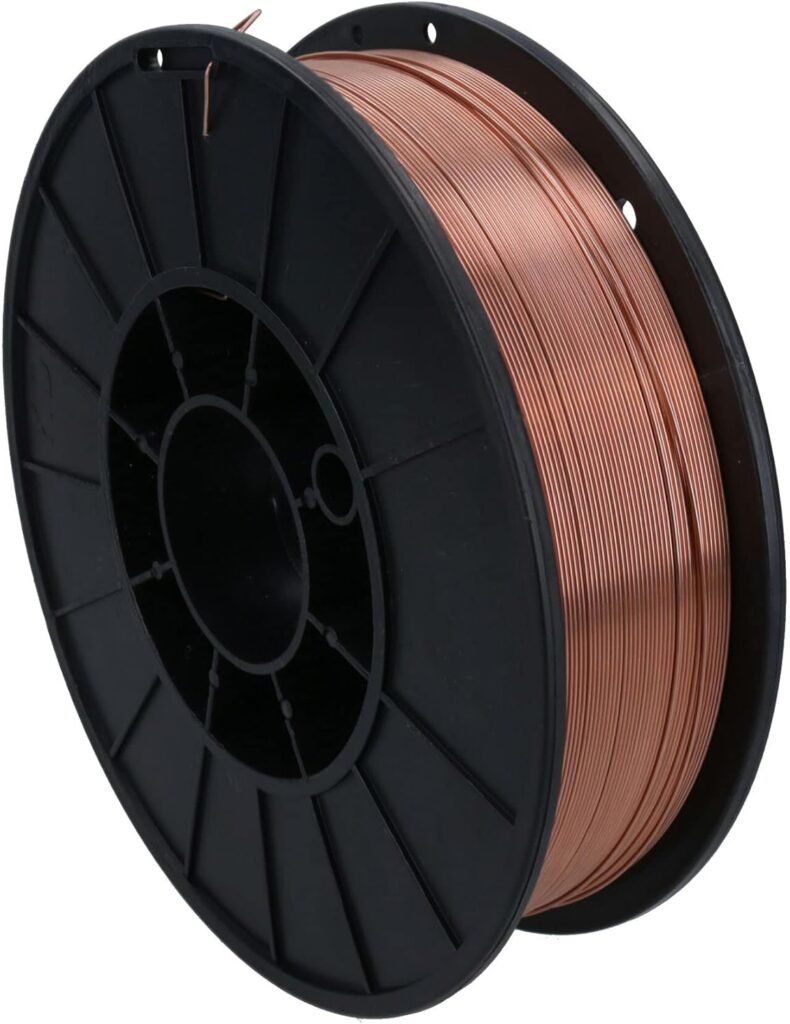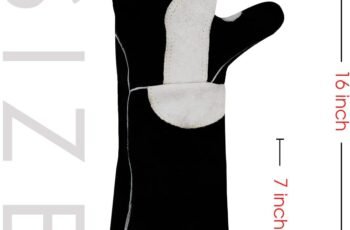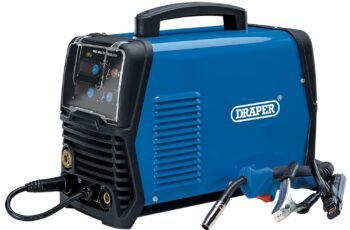Ad Blocker Detected
Our website is made possible by displaying online advertisements to our visitors. Please consider supporting us by disabling your ad blocker.
Looking for a dependable spool of MIG wire that fits your mild steel projects and works well with Argon or CO2?
Product overview: 0.6mm Mild Steel Mig Welding Wire Spool Gas Argon CO2 5kg Reel Copper Coated
You’ll find this product described as “0.6mm Mild Steel Mig Welding Wire Spool Gas Argon CO2 5kg Reel Copper Coated,” which sums up the basics in one line. It’s a 0.6mm diameter copper-coated mild steel MIG wire on a 5.0 kg spool, intended for gas-shielded MIG welding with Argon, CO2, or mixes of those gases.
This spool is designed to be a general-purpose wire for mild steel and to fit most gas MIG welding setups. The copper coating helps with feeding and corrosion resistance, while the wire diameter and spool weight make it suitable for hobbyists and light industrial use.
Key specifications
Below you’ll get a clear summary of the most important specs so you can quickly check fit and suitability for your welder and projects. This also helps you compare the spool with other wires at a glance.
| Attribute | Detail |
|---|---|
| Product name | 0.6mm Mild Steel Mig Welding Wire Spool Gas Argon CO2 5kg Reel Copper Coated |
| Wire diameter | 0.6 mm (approx. 0.024 in) |
| Weight | 5.0 kg (single spool) |
| Material | Mild steel core, copper-coated surface |
| Suitable gases | Argon, CO2, Argon/CO2 mixes |
| Welding process | Gas-shielded MIG (GMAW) |
| Recommended use | General mild steel welding — sheet metal, light fabrication, automotive repair |
| Compatibility | Most gas MIG welders that accept 5 kg spools and 0.6 mm wire |
| Packaging | Single spool, often in a plastic or cardboard box (check seller) |
What’s included and immediate fit considerations
You’ll typically receive one 5 kg spool of 0.6 mm copper-coated mild steel MIG wire. Make sure you check spool holder dimensions on your MIG welder so the hub fits the spool without binding.
If your machine expects a different spool weight or diameter, you might need an adapter or a different spool mount. Also check your liner and contact tip sizes — 0.6 mm wire will require matching consumables for optimal feeding and arc stability.
How the wire performs in typical welding tasks
You’ll want to know how it behaves when you put a bead down. This wire aims to give consistent feeding, predictable arc characteristics, and adequate penetration for thin to medium-thickness mild steel.
In practice, 0.6 mm is a versatile size that balances heat input and control. You’ll find it useful for sheet metal, light fabrication, and vehicle bodywork where too much heat would warp the part, but enough penetration is required for sound welds.
Arc stability and bead appearance
You’ll notice that copper-coated mild steel wires often produce a smooth, steady arc when matched with the right gas and welding settings. The wire’s copper plating reduces oxidation and improves electrical contact, which helps feeding and arc initiation.
Bead appearance will depend on your settings and technique. With Argon/CO2 blends you’ll typically get a relatively clean bead with manageable spatter. Pure CO2 gives deeper penetration but tends to produce more spatter and a rougher bead profile.
Compatibility with gases
You can use this wire with pure Argon, pure CO2, or mixtures such as 75/25 Argon/CO2. You’ll get different arc characteristics depending on the gas:
- Argon-rich mixes: smoother arc, less spatter, better control on thin material.
- CO2-rich mixes: more penetration, more aggressive arc, more spatter.
- Pure CO2: economical and penetrating, but rougher finish and more spatter.
Choose the gas based on the part thickness and finish requirements you have for your project.
Practical setup and welding settings
Getting the machine dialed in is where you’ll spend most of your time. You’ll want to start with manufacturer-recommended settings if available, then tweak based on bead appearance and penetration.
Before you weld, confirm the following: wire diameter (0.6 mm), contact tip and liner compatible sizes, correct polarity (usually DCEP for solid mild steel wire), and appropriate shielding gas flow (typically 15-20 L/min for Argon/CO2 mixes, but adjust for wind and nozzle size).
Typical voltage and wire feed speed ranges
You’ll adjust voltage and wire feed speed to control heat input and bead formation. While specific values depend on your machine and material thickness, these are ballpark starting points for 0.6 mm wire on mild steel:
- Material thickness 0.8–1.5 mm (thin sheet): lower voltage, lower wire feed speed.
- Material thickness 1.5–3.0 mm (light fabrication): medium voltage, moderate feed speeds.
- Material thickness >3.0 mm (heavier work): higher voltage, higher feed speed, possibly multiple passes.
Start conservatively and increase wire feed speed to reduce penetration or decrease it to increase bead height. Watch the bead profile and adjust voltage to maintain a smooth, slightly convex bead without undercut.
Contact tips, liners, and drive rolls
You’ll need a contact tip sized for 0.6 mm wire — typically labelled for 0.6 mm or .024 in. Use a clean, correctly sized liner to reduce friction and feeding issues. If your shop uses softer liner materials in dirty environments, consider a Teflon liner for smoother feed with low-friction properties.
Drive rolls should match the wire type: U-groove or knurled rolls work well for copper-coated solid wires. If your feeder has a selection, start with U-groove to avoid deforming the wire.
Applications and best-use scenarios
You can use this spool for a wide range of mild steel welding tasks. It’s flexible enough for hobbyists, automotive repair, small fabrication shops, and maintenance repair.
Because it’s 0.6 mm, it’s particularly well-suited for thin to medium sheet metal work where precision and control matter. If you’re working on thicker structural sections, you might opt for a larger diameter (e.g., 0.8 or 1.0 mm) for faster deposition.
Automotive and bodywork
If you work on car panels, brackets, or light chassis repairs, this wire will help you produce tidy welds without excessive heat input that would warp panels. With Argon-heavy mixes you’ll maintain better control and less burn-through on thin sheet.
Your prep work—cleaning paint, rust, and oil—will still be crucial. The wire performs best on clean, bare metal or metal prepared with appropriate grinders and wire brushes.
Fabrication and light manufacturing
You’ll find this wire useful for making frames, gutters, brackets, and light-duty structural components. Its consistent feed helps when you have to weld long seams or repeatable joints in small batches.
If your production requires faster deposition, look at larger wires, but for precision and control this 0.6 mm wire is a strong choice.
Build quality, spool handling, and storage
You should expect a reasonably well-packed spool with protective copper coating that reduces rust and improves conductivity. However, storage conditions will affect performance — moisture and contaminants can degrade wire quality.
Keep your spool in a dry area and, if possible, sealed in original packaging until use. If the wire absorbs moisture, you could see porosity or spatter during welding.
How to store the spool
Store the spool in a dry, temperature-controlled space away from humidity and corrosive atmospheres. If you won’t use the entire spool at once, consider placing it in a resealable bag with desiccant or storing it in a spool rack inside your shop.
Also avoid dropping or banging the spool, since mechanical damage to the wire can cause feeding issues or bird-nesting when you thread it through your liner.
Handling tips to prevent feeding issues
Handle the spool carefully when loading. Feed the wire slowly until it reaches the contact tip and check for smooth unspooling. If your wire tangles or kinks on the spool, unspool enough to cut the damaged portion and rewind carefully or replace the spool.
If you notice increased resistance or erratic feed, inspect the liner and drive rollers for wear, contamination, or improper tension.
Common problems and troubleshooting
Even with a good spool, you might encounter issues. You’ll get the best results if you systematically check machine settings, consumables, and part preparation.
Typical problems include feeding issues, excessive spatter, porosity, burnback, and inconsistent arc. The following troubleshooting steps will help you find and fix the problem.
Feeding issues and bird-nesting
If the wire jams or forms a bird’s nest at the feeder, check spool brake tension, drive roll pressure, liner condition, and spool orientation. Too loose spool tension or insufficient drive roll pressure will let the wire slip; too much pressure will deform the wire.
Replace kinked wire sections, re-route the liner if necessary, and make sure the spool hub aligns with your feeder path.
Spatter and poor bead profile
If you’re seeing lots of spatter, try a different gas mix (more Argon for smoother arc) or fine-tune voltage and wire feed speed. Check the tip-to-work distance (stick-out) — too much stick-out increases spatter.
Contamination on joint surfaces can also cause spatter and porosity. Clean the metal thoroughly before welding.
Porosity and inconsistent penetration
Porosity often links to inadequate shielding gas coverage, contaminated wire or joint, or drafts in your welding area. Ensure gas flow is adequate and the nozzle is clear of splatter. If you weld outdoors, use a windbreak or reduce flow to prevent turbulence.
If penetration is inconsistent, tune voltage and wire feed speed and confirm correct contact tip and polarity settings.
Safety and best practices
Safety is non-negotiable. You’ll want to use appropriate PPE, ensure ventilation, and follow machine safety protocols to protect yourself and your workspace.
Welding generates fumes, UV radiation, sparks, and high heat. Use a welding helmet with the right shade, gloves, apron, and respiratory protection if ventilation is limited.
Recommended PPE and ventilation
Wear a suitable welding helmet, safety glasses under the helmet, flame-resistant jacket, leather gloves, and closed footwear. For confined spaces or prolonged welding, use a respirator rated for welding fumes or an extraction system.
Keep a fire extinguisher nearby and remove flammable materials from the welding area.
Electrical and machine safety
Ensure your MIG welder is properly grounded and that cables are in good condition. Turn off the machine when changing consumables or performing maintenance. Secure the workpiece and avoid contact with the workpiece or electrode when the machine is energized.
Pros and cons summary
You’ll want a concise list to weigh the decision, especially if you’re comparing several wires for purchase. Below are strengths and limitations you should consider.
Pros
- Good balance of control and penetration for thin-to-medium mild steel.
- Copper coating improves feedability and reduces oxidation.
- 5 kg spool provides a solid amount of wire for hobby and small shop use.
- Compatible with Argon, CO2, and gas mixes, giving you flexibility.
- Generally cost-effective for routine welding tasks.
You’ll appreciate this wire’s versatility across common welding situations and its ease of use with properly set up equipment.
Cons
- 0.6 mm may not be optimal for heavy structural work requiring high deposition rates.
- Copper coating provides some protection but won’t replace proper storage in high-humidity environments.
- If your welder or feeder uses different spool sizes or liner types, you may need adapters or replacements for compatibility.
- Pure CO2 welding will produce more spatter and rougher finish.
If you expect to weld heavy sections or require the fastest deposition, consider a larger diameter wire or a flux-cored alternative.
How this wire compares to alternatives
You’ll likely be choosing between solid copper-coated mild steel wire, flux-cored wire, stainless steel wire, or different diameters. Each has strengths depending on the job.
0.6 mm solid wire is a good middle ground for control and finish. Flux-cored wire can offer higher deposition and better performance outdoors (less sensitivity to wind) but usually more smoke and slag. Stainless wire is only for stainless material and is more expensive.
Solid wire vs. flux-cored
With solid copper-coated wire you’ll get cleaner welds and better control in joint appearance when using shielding gas. Flux-cored wire gives you higher deposition and the ability to weld without external shielding gas (self-shielded), which is helpful outdoors but with more cleanup.
Choose solid wire if you value finish and lower fume levels in a controlled environment. Choose flux-cored for speed, thicker sections, or outdoor welding.
Different diameters
If you’re consistently welding thicker sections, you’ll want larger diameters (0.8 mm or 1.0 mm) for higher deposition and better heat management. But for thin sheet or precise work, 0.6 mm reduces burn-through and gives you better control.
You’ll want to keep a range of diameters in your shop if you handle a variety of tasks.
Buying advice and value considerations
Deciding whether this spool is right for you means assessing cost-per-kg, expected consumption, and compatibility with your equipment. You’ll also want to factor in shipping and local availability.
A 5 kg spool is a commonly sold size that balances price-per-weight and ease of storage. If you weld occasionally, this size avoids waste compared to much larger spools, but if you weld daily you may find larger reels more economical.
How to check compatibility before buying
Check your MIG welder’s spool hub maximum spool diameter and inner bore size, liner spec, contact tip sizes, and drive roll type. Confirm the wire diameter is supported and that you can obtain the required consumables.
If the seller lists detailed dimensions or part numbers, match them to your machine. When in doubt, contact the seller or the machine manufacturer with the spool dimensions.
Price vs. quality
You’ll find budget wires that offer adequate performance but may vary in consistency and coating quality. Higher-priced wires often provide tighter manufacturing tolerances, better coatings, and less variability from spool to spool.
If your work demands repeatable weld quality, favor recognized brands with better QA, but if you’re a weekend hobbyist, a lower-cost option may be perfectly fine.
Maintenance and long-term care
You’ll get longer service life and consistent performance by keeping your spool and related consumables in good condition. Routine checks will prevent most issues.
Clean contact tips regularly, replace liners when you see wear or feeding issues, and keep the nozzle free of spatter. Periodically inspect the spool surface for corrosion or contamination before loading.
When to replace consumables
Change contact tips if the bore enlarges or the tip shows signs of wear or burnback. Replace liners if you notice increased feeding drag or if wire deforms inside. Swap nozzles when buildup prevents good gas flow.
Tracking consumable life will reduce downtime and give more consistent welds.
Frequently asked questions (FAQ)
You’ll often have specific questions before buying or using a 0.6 mm spool; here are answers to common points of confusion.
Can I use this wire with any MIG welder?
You can use it with most MIG welders that accept 5 kg spools and support 0.6 mm wire. Verify your spool hub and feeder compatibility, and ensure you have the correct tips, liners, and drive rolls.
Is copper coating necessary?
Copper coating improves electrical contact in the feeder and reduces oxidation during storage. While not strictly necessary, it generally enhances feeding reliability and shelf life.
What shielding gas should I use?
Use Argon/CO2 mixes for a smooth arc and good appearance; increase CO2 for deeper penetration if you need it. Pure CO2 is cost-effective but rougher and produces more spatter.
Will it work for welding galvanized steel?
You can weld galvanized steel, but you’ll need proper ventilation and fume extraction due to harmful zinc fumes. Grind away galvanization where possible before welding or use appropriate PPE and extraction.
Final verdict
You’ll find the “0.6mm Mild Steel Mig Welding Wire Spool Gas Argon CO2 5kg Reel Copper Coated” to be a practical, versatile option for many mild steel welding tasks. It’s especially useful for hobbyists, automotive repair, and light fabrication where control and bead appearance matter.
If your projects span thin to medium thicknesses and you want a dependable, copper-coated solid wire that works with Argon, CO2, or blends, this spool is a sensible pick. If you need higher deposition for heavy structural work or frequent outdoor welding, you may want to consider a larger diameter or flux-cored wire as alternatives.
If you want, I can help you pick exact voltage and wire feed speed starting points for a specific material thickness and gas mix, or compare this spool to particular competitor products you’re considering.
Disclosure: As an Amazon Associate, I earn from qualifying purchases.






